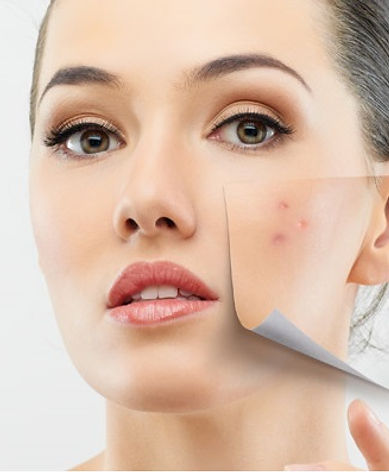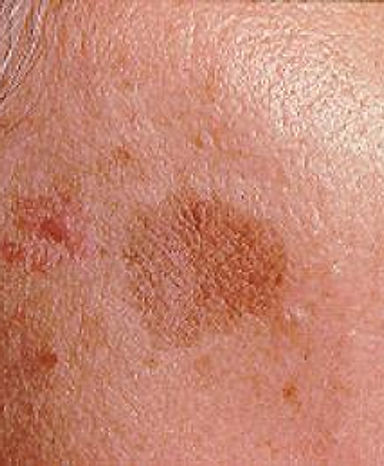3080 W 1st St Ste 102 Brooklyn, NY 11224
Tel: 718-207-7071

Port Wine Stains
A mark on the skin that resembles port wine (porto) in its rich ruby red color. Due to an abnormal aggregation of capillaries, a port wine stain is a type of vascular malformation (vascular birthmark). A port wine stain on the face is a sign of the Sturge-Weber syndrome. You'll see port-wine stains most often on faces, heads, arms, or legs. But they can appear anywhere on the body. These red marks are rarely harmful, and they usually aren't signs of any major health problem.
A port-wine stain happens when chemical signals in tiny blood vessels don't "turn off," and those blood vessels get bigger. The extra blood turns the skin red. Researchers found that port-wine stains start with the mutation of one specific gene.
Do they need treatment?
They are not harmful, but if just left alone port-wine stains tend to darken over the years. The overlying skin is smooth and flat at first. By middle age the overlying skin can become thickened and lumpy (a cobblestone-like appearance). A lot of people find it distressing to live with skin like this on their face.
How would a doctor diagnose a port-wine stain?
There is no particular test for a port-wine stain.
-
The diagnosis is made on the appearance of a newborn's skin.
-
A biopsy is not normally necessary.
-
A port-wine stain should not be confused with a 'salmon patch' or 'stork mark' that almost half of babies have, on the back of their neck in the midline. This fades over about a year and is entirely harmless.
Because very rarely something could be wrong with the baby's brain or eyes, if a baby has a port-wine stain they are usually checked by a specialist doctor. They will probably have a brain scan and a detailed eye check.
What are the treatments for port-wine stains?
-
Pulsed dye laser is the treatment of choice for port-wine stains. It is a treatment that was developed in the 1980s, so plenty is known about it.
-
The treatment fires tiny lasers at the blood vessels in the skin, making them seal off.
-
Initially just a small area will be treated, as a test. This can judge how well the child handles the treatment and whether they find it too painful. Children say it feels like being flicked by a rubber band.
-
The skin can be numbed with local anaesthetic cream beforehand. But if the child finds it too painful or there is a large area to be treated then they can have the treatment under a general anaesthetic. Most hospitals will only give a general anaesthetic over the age of 2 years for the laser treatment.
-
Typically about six laser sessions are given over a period of a year.
-
Laser works best when used at a young age and when the port-wine stain is pale pink rather than deep purple.
-
About three quarters of children have a good response to laser treatment, with the port-wine stain getting much paler.
-
In the long term the skin area can go back to a darker color, about ten years after laser treatment.
Solar Lentigines
Solar lentigines are patches of darkened skin that develop due to the accumulation of melanocytes upon exposure to ultraviolet (UV) radiation. Solar lentigines are extremely common in people over the age of 40 and in those who have fair-skin.
A solar lentigo tends to be flat, round, and oval or irregularly shaped. They range from tan to dark brown/black in color. It is common for solar lentigines to occur in small clusters on the face or back of the hands. Minimizing sun exposure is the best way to prevent the condition. Topical creams may help reduce the appearance of the spots. Laser surgery, cryotherapy, or chemical peels can remove solar lentigines.
Solar lentigines, though usually benign pigmented lesions, are a major concern for many patients because they’re typically found on sun-exposed areas such as the face, arms and hands, making them aesthetically undesirable. These lesions can vary in size and may increase in number with age.
A variety of treatment modalities have been used over the years to remove solar lentigines, including cryotherapy, trichloroacetic acid, topical tretinoin and bleaching agents such as hydroquinone. More recently, laser surgery has emerged as a novel and efficacious therapeutic modality.
Over the past several years, a plethora of studies have been published supporting the use of laser surgery to treat solar lentigines. To date, however, most studies support the superiority of laser technology in the efficacious treatment of solar lentigines.
.
What is laser skin rejuvenation?
Skin rejuvenation is used to treat fine lines on the face, skin lesions, sun spots, and pigmentation issues, including hyperpigmentation. laser, which emits short pulses of energy that target problem areas. The advantages of technology are:
-
It’s a precision therapy that doesn’t affect the skin or tissue around the treatment area
-
It’s a noninvasive treatment -- there is no cutting and no needles
-
It’s an in-office procedure with no downtime
-
There are minimal side effects -- some temporary redness or swelling may develop
-
Results are long-lasting
The laser works by sending pulses of light into your skin’s sub-layers, or supporting structure, and damages the cells and tissue you want to improve. The treatment triggers a healing response in your skin, which promotes collagen and elastin growth, leading to younger, healthier-looking skin. Your body will dispose of the damaged tissue naturally.
-
Skin lesions -- Laser therapy using pulsing light has been very successful in treating skin lesions and promoting healthy skin growth. The therapy can be used anywhere on your body and on most skin types.
-
Sun damage -- Age spots, sun spots, and other damage caused by sun exposure can be dealt with quickly and easily using laser therapy.
-
Hyperpigmentation -- If you have hyperpigmentation, which is a common condition that produces darker patches on the skin due to melanin excess, the treatment will target the darker areas to allow lighter skin to form.
-
Freckles, moles, café au lait spots, and birthmarks
-
Skin rejuvenation -- The laser treatment can rejuvenate your skin and reduce fine lines for an overall improvement in skin tone.
How many treatments do I need?
The number of treatments you will need depends on:
-
What you want to target
-
The size of the area you want to treat
-
The goal of your treatment
Usually, each treatment lasts 30 minutes, but several may be required in the same area for maximum results.





